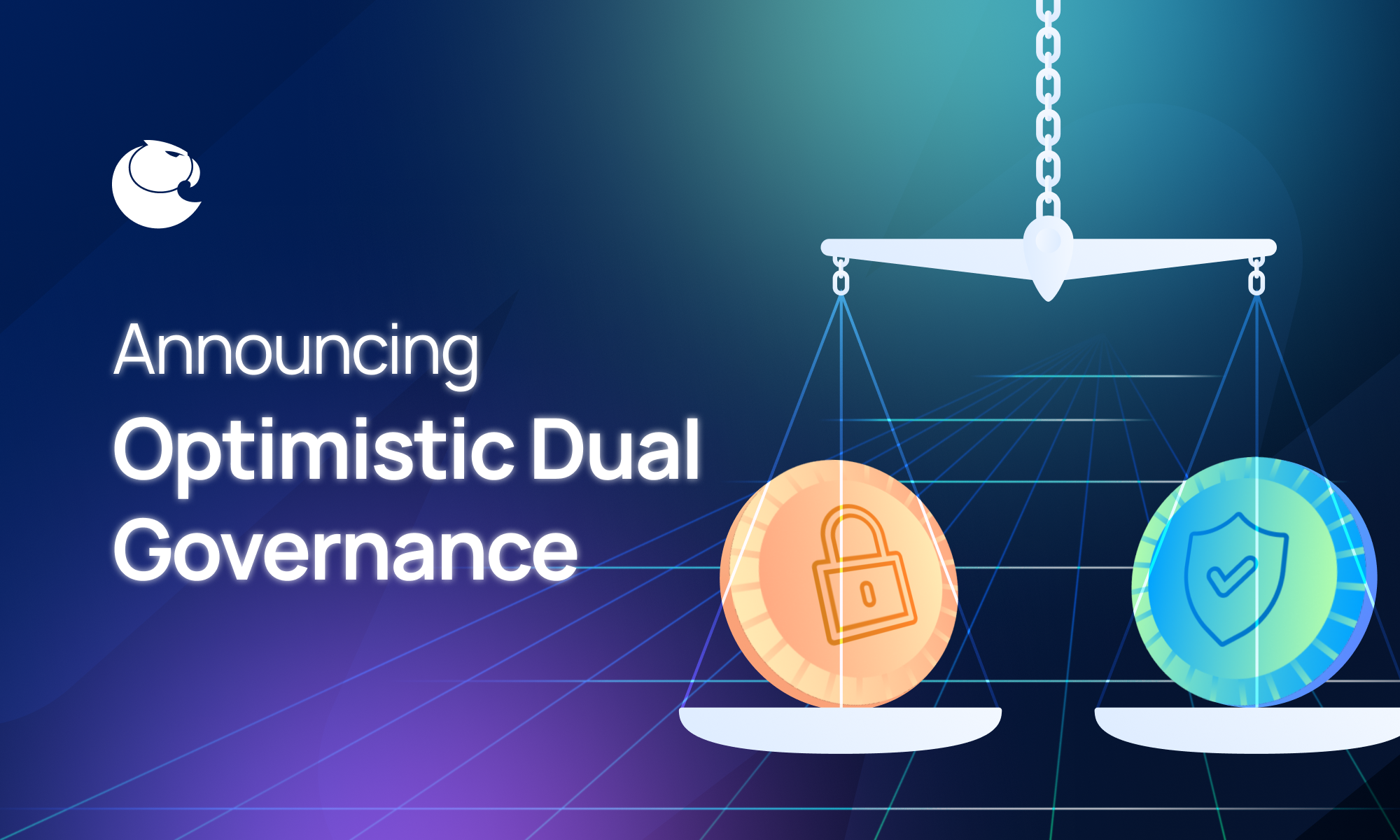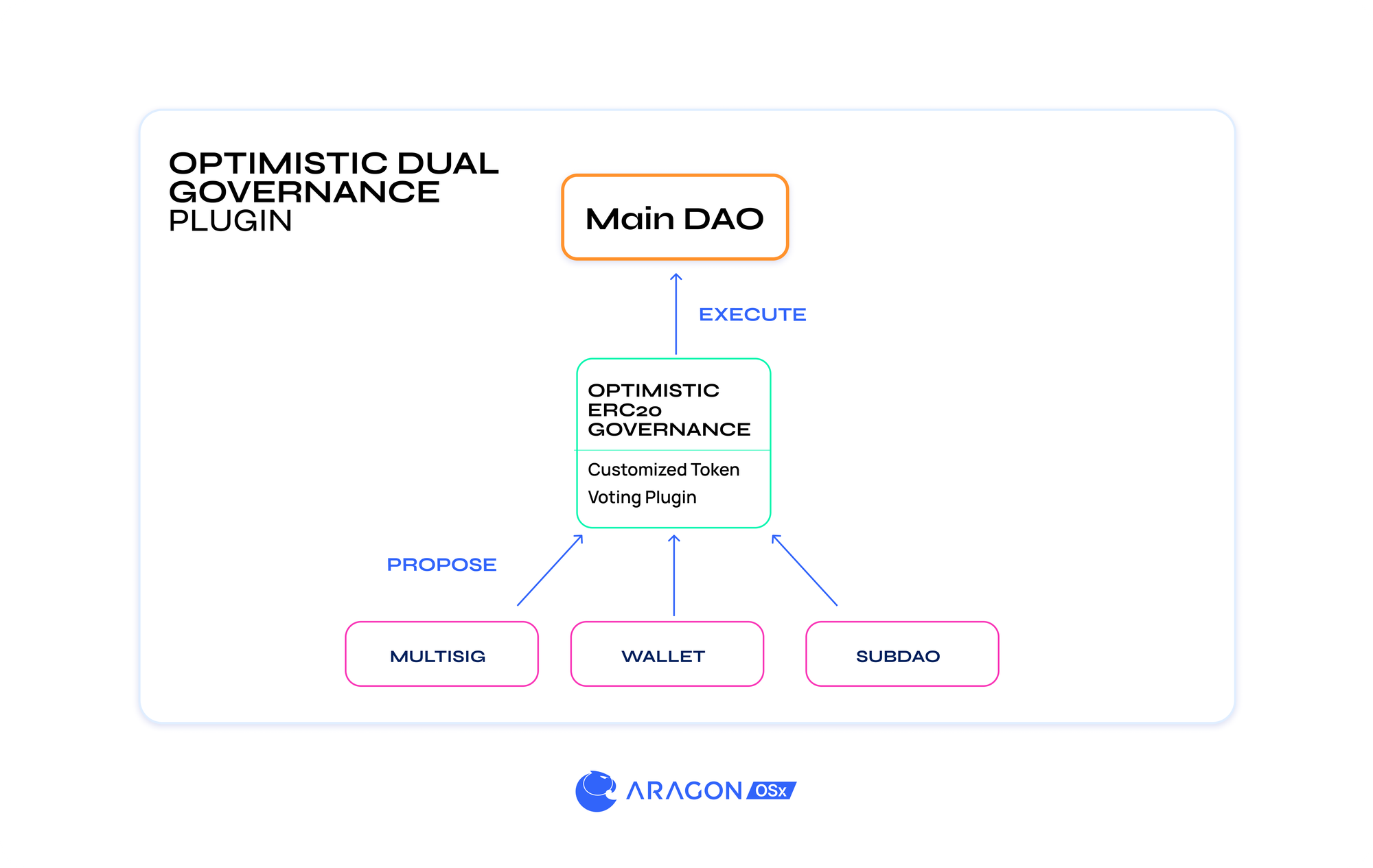Optimistic Dual Governance: An efficient governance design leveraging Aragon OSx plugins
This lean governance design gives key stakeholders a veto safeguard, while allowing teams to work efficiently.
Aragon

Introducing Optimistic Dual Governance, an efficient governance design using plugins on Aragon OSx. This governance design enables DAOs to create two different stakeholder groups with different governance permissions, and then execute proposals optimistically.
The plugins will undergo audits, but you can check out the progress of the first implementation here.
In a nutshell, Optimistic Dual Governance enables teams to work efficiently while allowing key stakeholders to veto proposals.
While any type of stakeholder group can be defined to meet your organization’s needs, this dual governance design was created for protocol DAOs with these two groups in mind:
- Teams that are actively building a protocol or doing operational work: such as a core team, guilds, developers, and any other active participants that are making updates, parameter changes, and upgrades to the protocol itself.
- Members of a Main DAO: any arbitrarily defined stakeholder group, which can be users, liquidity providers, stakers, investors, governance token holders, or another group that has an interest in protecting the protocol, but isn’t proactively involved in operations, development, or parameter changes.
Once you’ve defined your stakeholder groups, the next component of this design to understand is Optimistic Governance.
Optimistic Governance is when proposals pass as long as they’re not vetoed. Rather than standard token-based governance where proposals need to be voted on to pass, proposals in an optimistic governance structure pass automatically after a timelock period.
This means teams can move faster and don’t have to put proposals through a traditional governance process, however, this creates an attack surface if proposal creation is open to any wallet. For example, if the main DAO lets a proposal pass that misuses treasury funds, there’s no way to reverse the execution. So, it’s more secure for the DAO to have a defined group—in this case, an allowlist of addresses—that can be held accountable to proposals.
The design was largely inspired by teams that have been exploring Optimistic Dual Governance for their own DAOs, including Lido and StakedFLIP. The design by Jacob from Zora was also a significant inspiration.
Here’s how Optimistic Dual Governance on Aragon OSx works from proposal to execution:
- Proposal creation: Multisigs or subDAOs on the proposal allowlist can create proposals to the main DAO.
- Timelock period: During the timelock, the main DAO’s members can veto the proposal.
- Execution: If the main DAO doesn’t veto the proposal during the timelock, the proposal automatically executes.
Check out the architecture in the diagram below:

The permission management system at the heart of Aragon OSx enables a lean and efficient Optimistic Dual Governance design. It enables a main DAO to have separate permissions from those of the subDAOs, but all DAOs are able to operate within the same governance system.
This is the first iteration of this plugin. There are thousands of versions that could be created to suit the needs of your organization.
For example, in a future version of this plugin, different types of proposals can have longer or shorter timelocks. Minor updates could have a shorter timelock so it’s easier for teams to push small updates quickly, and significant updates could have a longer timelock, giving the main DAO members enough time to review them.
We can work with your team to build the iteration of this governance design that best suits your protocol. If you’re interested in using Optimistic Dual Governance, inquire here.
“OSx is the Unix of Ethereum—a future-proof DAO framework to build the DAOs that we can’t even imagine today. Dual governance will play a key role in communities that need to iterate fast while keeping valuable assets and rights in the hands of the token holders.”
— Jordi, Core OSx Developer

Why use Optimistic Dual Governance?
Separate stakeholder groups into active and passive roles
Simple token-based governance puts all stakeholders into a single, homogeneous group with the same permissions. But in reality, stakeholders range from active and high context participants building the protocol to users and infrastructure providers who want protection, but aren’t actively involved.
This governance design allows you to separate stakeholder groups based on the role they need to take in governing the protocol. You can think of this as an active group of proposers and a passive group of vetoers.
Many key stakeholders might not want to actively create proposals, especially those containing technical upgrades. However, they do want to make sure that the proposals that are passed are safe and are not misusing funds, introducing vulnerabilities, or compromising the future of the protocol. Splitting stakeholder groups and giving them different permissions with Optimistic Dual Governance is a solution for this.
Efficient governance enables teams to ship faster
Optimistic execution of proposals means that teams’ proposals are executed as long as they’re not vetoed. This design enables teams to iterate quickly, benefiting the health of the protocol as a whole.
And, if voter apathy is a problem in the organization, the teams aren’t held back. They don’t have to wait for proposals to get the votes required to pass—they're passed automatically after the timelock period. Teams also don’t need to take time out of their work to move proposals through multiple stages of voting or approvals. The main DAO stakeholders still have final approval over proposals, but the politics and process is significantly reduced.
Stakeholders in the main DAO keep control with the timelock and veto option
Stakeholders in the passive role — users, investors, liquidity providers, or others — don’t need to actively vote to make sure the protocol or product is being maintained. However, they are still in control, because they can veto proposals that aren't aligned with the DAO.
This design gives token holders final control over what happens to the protocol without having to actively participate in creating proposals. They can review proposals if they choose to, but don’t need to exercise their voting rights unless something needs to be vetoed.
Option to have entirely tokenless governance
One of the possibilities of this design is that both the teams and the main DAO could be entirely tokenless. For the main DAO, you simply need an allowlist of addresses that have permission to cast a veto vote. On the team side, you need an allowlist of addresses that have permission to create proposals.
Whether you’re pre-token or are not launching one at all, you can use this governance design. There’s no component of the design that requires you to mint a token.
Furthermore, these permissions and their implementation can be customized in multiple ways, such as assigning voting power or adjusting time locks.

What's next for this governance design:
More modularity
You can find the first iteration for the Optimistic Dual Governance plugin here, which will be undergoing audits.
For more complex organizations, a variation of this design could be a better fit, because it includes autonomy for subDAOs. Here’s what it could look like: the multisigs would be autonomous subDAOs, which could manage certain permissions by themselves, such as the ability to add and remove new internal members. They could also have their own governance process, such as token voting.
Governance minimization is a key goal of this governance design, and the future iterations will lean into this concept even more. By making the governance process lean and secure, both stakeholders and team members don’t need to spend so much time involved in governance.

We’re seeking partners to explore the boundaries of this model and feedback from more industry players. Inquire about using this governance design in your own DAO or protocol by filling out the form above to let us know what you need!
We can’t wait to learn about what you’re building.
Subscribe to The Eagle for weekly news on the Aragon Network
